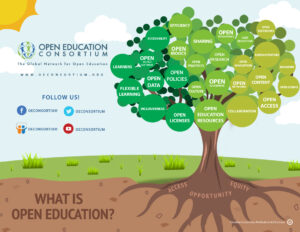Open Education was a completely foreign topic to me only a few days ago. However, it is already a direction that I think the education system can benefit from leaning into. My interpretation of open education is that it is the idea that educators can share, collaborate, and access tools, ideas, and resources openly and freely through digital means. Ultimately this will lead to inclusivity through equal access to education.

Retrieved from https://www.yearofopen.org/open-education/
Use in the Classroom
Professionally
The thought of having unlimited access to digital educational resources as a teacher sounds like a dream! In my classroom, I spend hundreds of dollars each year on teaching resources online to help support my students. As an intensive support teacher, with students with diverse and individualized needs, I find that even when paying for resources I am often adapting or making modifications to them in order to meet my student’s needs. Therefore, to have access to free, continually updated, or rejuvenated resources seems ideal and something that I can see myself contributing to.
Student Use
Open education and open educational resources would provide more opportunities for students. In the FIAP program that I work in, students are continually working on life and vocational skills. Having the opportunity to access courses or resources that would help build their resume would provide more opportunities in the post-secondary world.
That being said, after searching several different variations of wording, there appear to be very few open education courses that are designed for students with intellectual disabilities. This is not to say that my students could not access and succeed in courses that are available, however, in many cases, they may need extra support in completing them. In the future, I would love to be able to see and contribute to more inclusive open education opportunities that meet the needs of diverse students.
However, because open education resources are shared, developed, and adapted online, it creates barriers for those who do not have easy access to technology. It is because of this that I cannot help but continue to wonder – is open education really equitable? And how can we bridge this gap in ensuring that equal opportunities can be provided?

Amy, thank you for your post! I also work in the area of intensive needs and I agree with your thoughts on having access to online resources and content, or rather FREE resources. It is hard to find appropriate material and when you do, you have to pay so much, and half the time, you do not even get to see an example of what the content actually is! I find this process very frustrating, especially since I have spent around $3000 over the past 10 years on my own resources, just to support student learning.